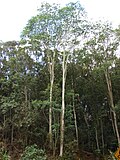| Falcataria falcata | |
|---|---|
 | |
| Specimen at Waiehu, Maui | |
| Scientific classification | |
| Kingdom: | Plantae |
| Clade: | Tracheophytes |
| Clade: | Angiosperms |
| Clade: | Eudicots |
| Clade: | Rosids |
| Order: | Fabales |
| Family: | Fabaceae |
| Subfamily: | Caesalpinioideae |
| Clade: | Mimosoid clade |
| Genus: | Falcataria |
| Species: | F. falcata |
| Binomial name | |
| Falcataria falcata | |
| Synonyms [1] | |
| |
Falcataria falcata (syns. Albizia falcata, Falcataria moluccana and Paraserianthes falcataria), commonly known as the Moluccan albizia, is a species of fast-growing tree in the family Fabaceae. [3] It is native to the Maluku Islands, New Guinea, the Bismarck Archipelago, and the Solomon Islands. It is cultivated for timber throughout South Asian and Southeast Asian countries. This tree is considered to be invasive in Hawaii, American Samoa and several other island nations in the Pacific and Indian Oceans. [4] [5] It reaches about 30 m (100 ft) tall in nature, and has a massive trunk and an open crown. [4] It is most famous for its remarkable rate of growth. It has been recorded growing 16 m (52 ft) in three years, 33 m (108 ft) in nine years and 45 m (148 ft) in seventeen years. [6]











